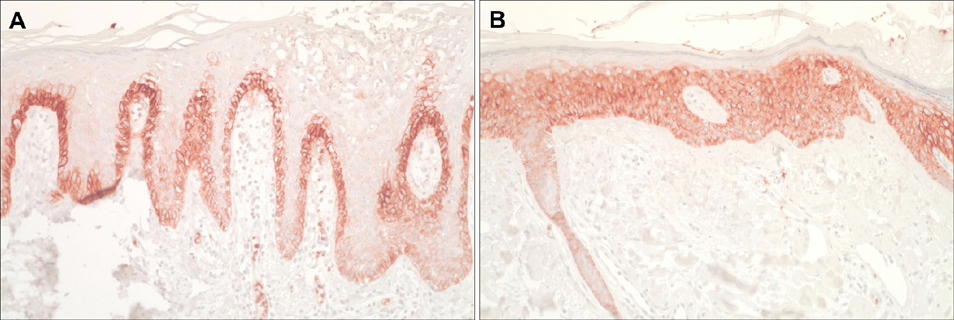Ann Dermatol.
2016 Aug;28(4):427-432. 10.5021/ad.2016.28.4.427.
Histopathological Differential Diagnosis of Psoriasis and Seborrheic Dermatitis of the Scalp
- Affiliations
-
- 1Department of Dermatology, Ajou University School of Medicine, Suwon, Korea. maychan@ajou.ac.kr
- 2Department of Pathology, Ajou University School of Medicine, Suwon, Korea.
- 3Department of Dermatology, Asan Medical Center, University of Ulsan College of Medicine, Seoul, Korea.
- KMID: 2344811
- DOI: http://doi.org/10.5021/ad.2016.28.4.427
Abstract
- BACKGROUND
The differential diagnosis of psoriasis and seborrheic dermatitis can be difficult when both conditions are localized to the scalp without the involvement of other skin sites.
OBJECTIVE
We aimed to evaluate the histopathological differences between psoriasis and seborrheic dermatitis on the scalp and identify favorable criteria for their differential diagnosis.
METHODS
We evaluated 15 cases of psoriasis and 20 cases of seborrheic dermatitis of the scalp that had been clinicopathologically diagnosed. Skin biopsy sections stained with H&E were examined. Additional immunohistochemistry was performed, including Ki-67, keratin 10, caspase-5, and GLUT-1.
RESULTS
On histopathological examination, mounds of parakeratosis with neutrophils, spongiform micropustules of Kogoj, and clubbed and evenly elongated rete ridges were significantly more frequently observed in psoriasis. Follicular plugging, shoulder parakeratosis and prominent lymphocytic exocytosis were significantly more common in seborrheic dermatitis. Moreover, significantly higher mitotic figures were observed in psoriatic lesions than in seborrheic dermatitis. Immunohistochemistry did not show any difference between psoriasis and seborrheic dermatitis.
CONCLUSION
Histopathological features favoring psoriasis include mounds of parakeratosis with neutrophils, spongiform micropustules of Kogoj, clubbed and evenly elongated rete ridges, and increased mitotic figures (≥6/high-powered field). Features indicating seborrheic dermatitis are follicular plugging, shoulder parakeratosis and prominent lymphocytic exocytosis. Immunohistochemistry was not helpful in differentiating psoriasis from seborrheic dermatitis.
MeSH Terms
Figure
Reference
-
1. Kim TW, Shim WH, Kim JM, Mun JH, Song M, Kim HS, et al. Clinical characteristics of pruritus in patients with scalp psoriasis and their relation with intraepidermal nerve fiber density. Ann Dermatol. 2014; 26:727–732.
Article2. Calonje E, Brenn T, Lazar AJ, McKee PH. McKee's pathology of the skin. 4th ed. Philadelphia: Elsevier/Saunders;2011. p. 180.3. Ackerman AB. Differential diagnosis in dermatopathology II. Philadelphia: Lea & Febiger;1988. p. 2.4. Braun-Falco O, Heilgemeir GP, Lincke-Plewig H. Histological differential diagnosis of psoriasis vulgaris and seborrheic eczema of the scalp. Hautarzt. 1979; 30:478–483.5. Lever WF, Elder DE. Lever's histopathology of the skin. 10th ed. Philadelphia: Wolters Kluwer Health/Lippincott Williams & Wilkins;2009. p. 181.6. Weedon D, Strutton G, Rubin AI. Weedon's skin pathology. 3rd ed. Edinburgh: Churchill Livingstone/Elsevier;2010. p. 80.7. Abdou AG, Maraee AH, Eltahmoudy M, El-Aziz RA. Immunohistochemical expression of GLUT-1 and Ki-67 in chronic plaque psoriasis. Am J Dermatopathol. 2013; 35:731–737.
Article8. Bovenschen HJ, Seyger MM, Van de Kerkhof PC. Plaque psoriasis vs. atopic dermatitis and lichen planus: a comparison for lesional T-cell subsets, epidermal proliferation and differentiation. Br J Dermatol. 2005; 153:72–78.
Article9. Salskov-Iversen ML, Johansen C, Kragballe K, Iversen L. Caspase-5 expression is upregulated in lesional psoriatic skin. J Invest Dermatol. 2011; 131:670–676.
Article10. Rudolph P, Peters J, Lorenz D, Schmidt D, Parwaresch R. Correlation between mitotic and Ki-67 labeling indices in paraffin-embedded carcinoma specimens. Hum Pathol. 1998; 29:1216–1222.
Article11. Tochio T, Tanaka H, Nakata S. Glucose transporter member 1 is involved in UVB-induced epidermal hyperplasia by enhancing proliferation in epidermal keratinocytes. Int J Dermatol. 2013; 52:300–308.
Article
- Full Text Links
- Actions
-
Cited
- CITED
-
- Close
- Share
- Similar articles
-
- Histopathological and Immunohistochemical Differentiation between Psoriasis and Seborrheic Dermatitis of the Scalp: Based on Langerin and CD1a
- Favorable Response of Pityriasis Amiantacea to Isotretinoin
- Treatment of seborrheic dermatitis with itraconazole
- The Study on the Incidence of Pityriasis Versicolor of the Scalp in a Normal Person and Patients with Seborrheic Dermatitis
- A Case of Seborrheic Dermatitis Caused by Overgrowth of Malassezia globosa



